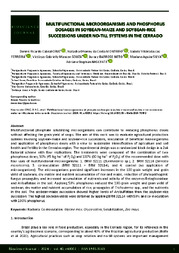Multifunctional microorganisms and phosphorus dosages in soybean-maize and soybean-rice successions under no-till systems in the cerrado.
Multifunctional microorganisms and phosphorus dosages in soybean-maize and soybean-rice successions under no-till systems in the cerrado.
Author(s): CRUZ, D. R. C.; MONTEIRO, N. O. da C.; FERREIRA, I. V. L.; SOUZA, V. G. M.; BARROSO NETO, J.; SILVA, M. A.; NASCENTE, A. S.
Summary: Multifunctional phosphate solubilizing microorganisms can contribute to reducing phosphorus doses without affecting the grain yield of crops. The aim of this work was to evaluate agricultural production systems involving soybean-maize and soybean-rice successions, inoculation of beneficial microorganisms and application of phosphorus doses with a view to sustainable intensification of agriculture and soil health and fertility in the Cerrados region. The experimental design was a randomized block design in a 2x4 factorial scheme with four replications. The treatments were composed of the combination of two phosphorus doses, 50% (45 kg ha-1 of P2O5) and 100% (90 kg ha-1 of P2O5) of the recommended dose with four uses of multifunctional microorganisms: 1. BRM 32111 (Burkholderia sp.), 2. BRM 32114 (Serratia marcescens), 3. co-inoculation (BRM 32111 + BRM 32114), and 4. control (no application of microorganisms). The microorganisms provided significant increases in the 100-grain weight and grain yield of soybeans, dry matter and nutrient accumulation of rice and maize, reduction of phytopathogenic fungus propagules, and increased accumulation of nutrients and activity of the enzymes Betaglicosidase and Arilsulfatase in the soil. Applying 50% phosphorus reduced the 100-grain weight and grain yield of soybean, dry matter and nutrient accumulation of rice, propagules of Trichoderma spp., and the nutrients in the soil. The soybean-maize succession showed higher levels of Arylsulfatase than the soybean-rice succession. The highest soybean yields were obtained by applying BRM 32114 with 50% and co-inoculation with 100% phosphorus.
Publication year: 2024
Types of publication: Journal article
Unit: Embrapa Rice & Beans
Keywords: Arroz, Bactéria, Cerrado, Co-inoculation, Glycine Max, Microorganisms, Microrganismo, Milho, Oryza Sativa, Plantio Direto, Soja, Zea Mays
Observation
Some of Embrapa's publications are published as ePub files. To read them, use or download one of the following free software options to your computer or mobile device. Android: Google Play Books; IOS: iBooks; Windows and Linux: Calibre.
Access other publications
Access the Agricultural Research Database (BDPA) to consult Embrapa's full library collection and records.
Visit Embrapa Bookstore to purchase books and other publications sold by Embrapa.

